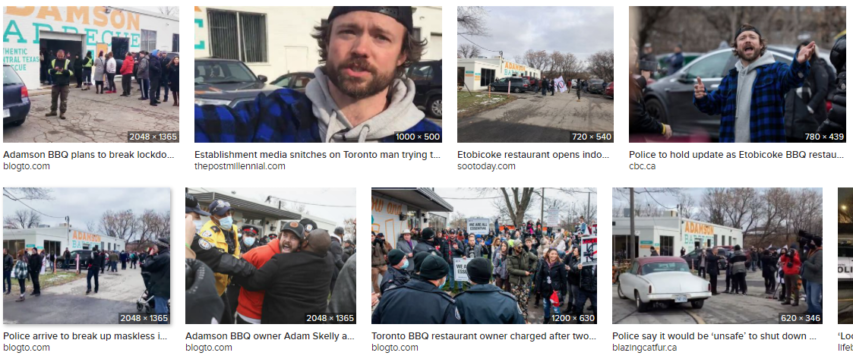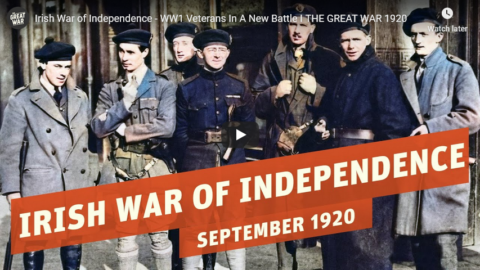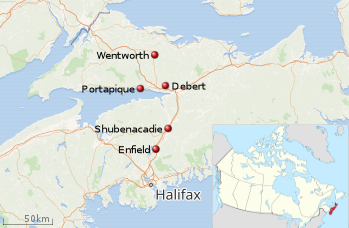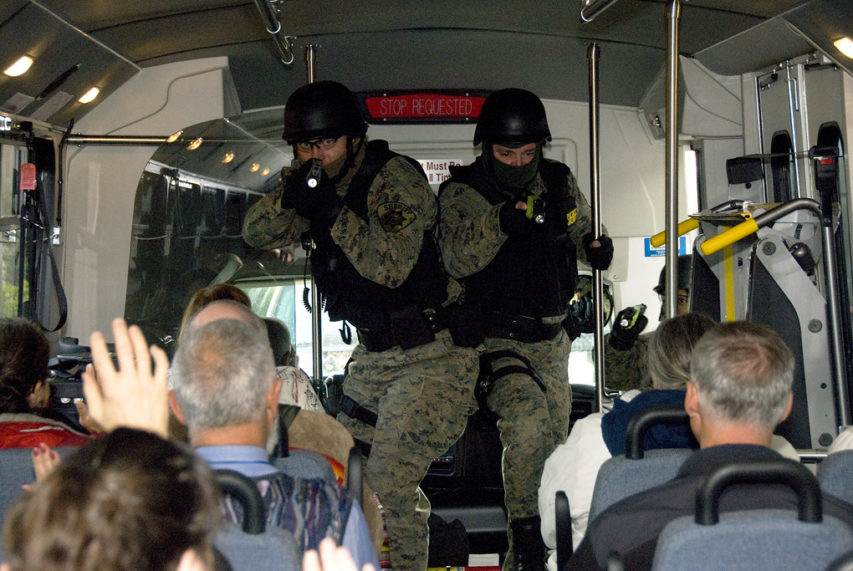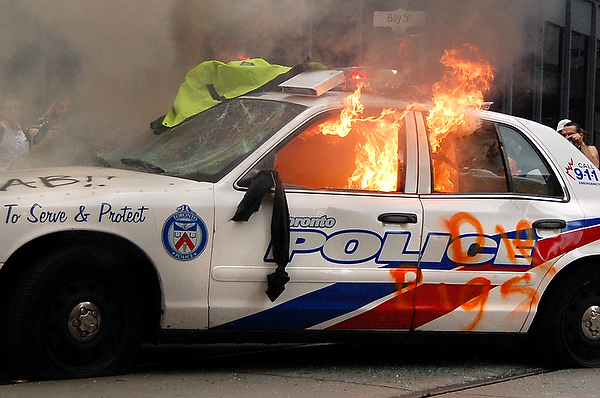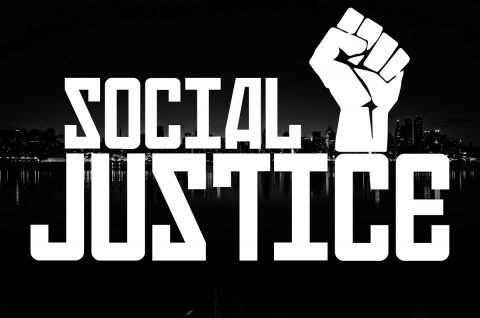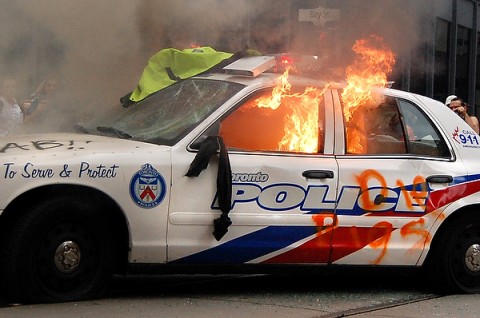As I write this, another wave of ballistic hyperbole is sweeping across the Internet. There’s a new bullet out! It sets the paradigm on its ear! Gun owners are drooling for this, the last bullet you’ll ever need! Blah, blah, blah, yakkity-shmakkity.
Stick around long enough and you’ll notice this phenomenon happen every few years. You’re sitting there, minding your own business, and the next thing you know, friends from work or church or the book club who know you as “The Gun Expert” are coming up to you and asking about this bullet that’s being hyped in the mainstream media as either the surest felon-stopper since Wyatt Earp or the biggest menace to society since John Dillinger.
It’s rare for something as esoteric as a projectile design to come to the attention of the non-gun press. Generally, for that to happen, it takes one of two things: either a mainstream manufacturer made an unusually poor PR choice in the bullet naming *cough*BlackTalon*cough*, or someone has launched a buzzword-laden press release with all the discrimination of a desert island dweller putting notes in bottles.
[…]
When a new Magic Bullet is launched and makes media waves, I always apply two filters as to whether it’s worth chasing down. The first filter is “Are the police using this?” This is not necessarily because I think that the police are all-that-and-a bag-of-chips in the gear-selection department, but they’ve generally been okay with bullets for the last 15 or 20 years and, should I ever have to justify my choice of rounds in a courtroom, it would be nice to be able to say “You, alright! I learned it by watching you!” like the kid in the commercial.
The second filter? The second filter is “Is this cartridge sold in six-round blister packs with pictures of explosions and rappelling ninjas on them?” Because if it is, well, I’m just not Operator enough.
Tamara Keel, “No Magic Bullet”, GunsAmerica Digest, 2018-11-27.
July 17, 2021
QotD: “Magic” bullets
July 7, 2021
The “Squirrel!” distractions will end when it’s convenient for certain people and groups
Jay Currie considers the constant barrage of distractions that appear to be preventing most people from noticing what is actually going on in Canada:
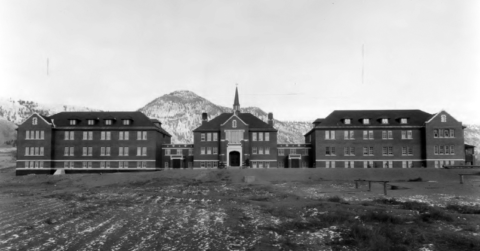
Kamloops Indian Residential School, 1930.
Photo from Archives Deschâtelets-NDC, Richelieu via Wikimedia Commons.
The remarkable thing about all of these little snippets of news is that they seem to be regarded as business as usual. Being taxed by an inflation rate which is well into the double digits does not cut through the COVID hype. Vandalism and arson purportedly in rage over residential school deaths which we have known about for decades attracts very little comment – though many First Nations people are not very happy that reservation churches which have served their communities for years are being burnt. People seem to shrug off the heat wave deaths and ambulance delays.
I expect very little from government at any level. A reasonably sound currency, a degree of public order and emergency services which can deal with the inevitable surges in demand.
The emergency services issue is probably the most easily fixed. Yes, having more para-medics is part of the solution but planning a reponse to these sorts of surge emergencies which tries to avoid the need for an ambulance in the first place is important too. Most of the dead were old, in many cases, very old. It should not be impossible to identify those older people and have a plan for these sorts of emergencies. Something as simple as a “Helpful Neighbour” program on a voluntary basis would be a good first step.
Restoring public order is more complicated. First, you have to have the political will to actually take on the problem. As we saw a couple of years ago, when it comes to people purporting to act on behalf of First Nations/environmental causes that will is absent. But even if the politicians decided that enough was enough there needs to be an investigation and an understanding of how the “spontaneous” vandalism and arson and blockades are driven. That is going to require rooting around in the activist community which will be, to say the least, difficult. The people who are actually creating the public disorder pay close attention to operational and communications security. Suffice to say this stuff is not being organized on a Facebook page.
Restoring order is also going to require a look at who benefits from disorder. To take an example: was it co-incidence that the sad fact of the Kamloops residential school graveyard came up just as the inquiry into Canada’s Winnipeg Lab’s connection to the Wuhan virology lab was heating up? The fact of there being a graveyard had been know for decades. The ground radar was being used to determine the boundaries so a new fence could be built. Yet, somehow, the number of bodies became headline news. I suspect, but cannot prove, that this was no accident. Public order will be restored when disorder is no longer in anyone’s interest.
June 21, 2021
“The public are getting a little bit fed up of virtue-signalling police officers when they’d really rather we just locked up burglars”
Gawain Towler on the sudden, unexpected — and undoubtedly unwelcome to self-appointed guardians of the official narrative — appearance of what sounds surprisingly like common sense from a top police officer in Britain:
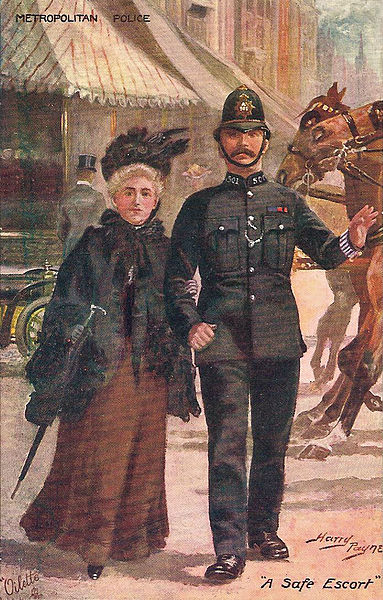
“A Safe Escort” by Harry Payne (1858-1927), first published in August 1911 but possibly painted a few years earlier. From the back of the card: “Among the hundred and one duties of the London Policeman he is here depicted as a kindly protector, halting the traffic as he escorts a Lady across the congested streets. This is essentially a London incident, and has no parallel in any other Police Force in the world.”
Photo of the Tuck’s Oilette by Leonard Bentley via Wikimedia Commons.
Has Robert Peel been reincarnated as the Chief Constable for Manchester?
“But officer, if you are not on your knee, and wearing a rainbow lanyard, how do we know that you are on the side of the oppressed, the intersectional, the poor, downtrodden graduates of minor universities?”
“I’m sorry madam, may I call you madam? I am on the side of the law.”
The promotion of Stephen Watson as the new Chief Constable for Manchester comes as a shaft of light cutting through the murk of muddled thinking. He has said two things that will resonate with millions and will cause consternation amongst thousands:
I would probably kneel before the Queen, God and Mrs Watson, that’s it … The public are getting a little bit fed up of virtue-signalling police officers when they’d really rather we just locked up burglars.
It sounds like the first blast of the trumpet, but not only does it strike an astonishingly different note than the honky tonk tunes played by other constabularies. Stentorian and self confident it also marks a huge departure in that he makes a very public statement that he would kneel before God. A very courageous statement in the current climate in itself. But it is his approach to policing that strikes the eye.
One almost feels that as was once the case, each new officer in the Manchester Metropolitan Area will be issued with Sir Robert Peel’s 1829 Nine Principles of Policing. It is worth our while looking at those principles and deciding whether or not to accept that they should remain at the core of policing, or be junked as impossibly dated.
What is clearly apparent is that Peel’s principles are at heart about consent. Famously it described the police as merely the citizens in uniform, or that “the police are the public and that the public are the police, the police being only members of the public who are paid to give full time attention to duties which are incumbent on every citizen in the interests of community welfare and existence”.
Underlying this basic thought is an understanding that the police rely, entirely on the goodwill of the populace, if they wish to carry out their basic duties. In order to fulfil their functions and duties they are “dependent on public approval of their existence, actions and behaviour and on their ability to secure and maintain public respect”.
March 27, 2021
“Unfortunately for the RCMP, obstruction of justice and tampering with evidence is very much a criminal offence and it looks like the boys in red should lawyer up”
An investigation into the conduct of the Royal Canadian Mounted Police (RCMP) shows an organization that firmly believes — and acts — as though it is above the law:
To its credit, RCMP leadership accepted the findings of the CRCC [Civilian Review and Complaints Commission]. But the rank and file membership, the actual police officers who interact with the public, and their union, have rejected the report, calling it biased.
All of this is a stain on Canada’s top law enforcement agency, and part of a deeper failure by the RCMP to meaningfully address its own reluctantly acknowledged systemic racism toward Indigenous peoples, but it is far from criminal misconduct.
Unfortunately for the RCMP, obstruction of justice and tampering with evidence is very much a criminal offence and it looks like the boys in red should lawyer up.
In the course of the CRCC investigation, the commission requested all recordings, transcripts, and radio communications from the day of the shooting. These communications would have undoubtedly been important to the investigation and could have provided a window into why the RCMP engaged in illegal and discriminatory conduct.
But the RCMP destroyed those records. They claimed that it was part of a routine procedure and that records with no evidentiary value have a shelf life of two years. Except the RCMP knew that there was an ongoing CRCC investigation and a civil lawsuit by the Boushie family when they destroyed the records.
If you or I destroyed relevant records, while staring down a barrel of a civil lawsuit or investigation, we would end up before a judge on charges.
Every time I ask the RCMP to destroy records relating to my clients who have been acquitted at trial, even after years have passed, I am met with a wall of resistance. So it seems a bit convenient when relevant documents are so easily destroyed when it is the RCMP who are being investigated.
The CRCC report also discloses that the RCMP conducted a parallel investigation into the Boushie incident — with officers questioned and evidence gathered. This RCMP investigation not only potentially contaminated the CRCC inquiry, but the RCMP kept their investigation a secret and failed to disclose the fruits of their internal investigation to the CRCC.
This all reeks of a cover up and an attempt to obstruct justice.
March 23, 2021
The Beretta PM-12S Submachine Gun
Forgotten Weapons
Published 22 Apr 2017For several decades, the Beretta company’s handguns and submachine guns were nearly all designed by the very talented Tulio Marengoni … but nothing can last forever. After World War 2, Beretta engineer Domenico Salza began working on a new SMG design, one which would be more compact and more controllable that the M38 family. At roughly the same time, Beretta changed its naming convention to avoid looking like it was still marketing old guns; the Model 38/49 become the Model 1. Each new design took the next number, until in 1958 the Model 12 was introduced.
The Model 12 (and this improved Model 12S) has both forward and rear pistol grips, and a bolt which wraps around the barrel well forward of the chamber. This movement of the reciprocating mass forward helps reduce the gun’s tendency to climb, and makes the Model 12 a quite capable design. It is still in common use with a variety of military and police forces today — including being a common sight in the hands of security guards in Italy today.
http://www.patreon.com/ForgottenWeapons
Cool Forgotten Weapons merch! http://shop.bbtv.com/collections/forg…
If you enjoy Forgotten Weapons, check out its sister channel, InRangeTV! http://www.youtube.com/InRangeTVShow
November 28, 2020
Showdown at the O.K. BBQ joint
Toronto police reacted with overwhelming force to a rebellion centred on a small business in Etobicoke, intending to overawe any more potential lockdown opponents on Thursday. Jay Currie is of the “worse before better” school on this particular flare-up of public sentiment:
Well over 100 Toronto police officers and at least ten horses shut down Adamson’s BBQ today. They arrested the proprietor for “trespass” on his own property.
His sin was, of course, opening when Toronto is under “lockdown”. And then opening again and then, today, getting around the changed locks on his premises and opening again.
Now there will be plenty of people who will say, “Well, it’s the law and necessary if we are going to ‘stop the spread'”. But I suspect there will be a strong minority who will say, “Lockdowns don’t work and Costco is in full operation a block away.” Have at it, my interest is in the show of force.
For the City of Toronto and the Province of Ontario, Adamson’s was a point of rebellion which had to be crushed. At any cost. If Adamson’s was able to open the entire pandemic lockdown regime would collapse. So out came 100+ cops and the horses. (I was surprised there was not a tactical vehicle or two.)
Given that there were all of about a hundred people at the BBQ spot today this was more than sufficient force to ensure Adamson’s would not be able to open. No doubt Mayor Tory and Premier Ford are pretty sure the job is done. Adam Skelly, the owner, is cooling his heels in custody pending a bail hearing. (If that hearing goes as I expect, there will be compliance conditions attached to his bail, namely no re-opening.)
Big government relies upon the general complacency of its citizens. A couple of hundred people showing up to a BBQ joint can be handled with a large police presence. A couple of thousand? Much more difficult. 20,000, not a chance.
I keep saying to my very worried wife, “Worse before better.” Which means that before there is any chance that reason, moderation and good government is restored, things have to get a lot worse. On the left, groups like BLM and Antifa work very hard to create martyrs for their narrative. So far with limited success. Adam Skelly may have set in motion the process which will make him a living martyr for common sense and a degree of justice.
As of Friday morning the GoFundMe campaign for Skelly had reached $130,000 (I’m expecting it to be shut down for “reasons” any time soon … but it was still online and accepting donations when I checked at 10am).
October 9, 2020
Speaking in code and public health
In The Line, Joshua Hind relates the tragedy that forced US emergency services to wean themselves off their many confusing (and sometimes conflicting) spoken codes and use plain language to help reduce tragic misunderstandings among different emergency response organizations:
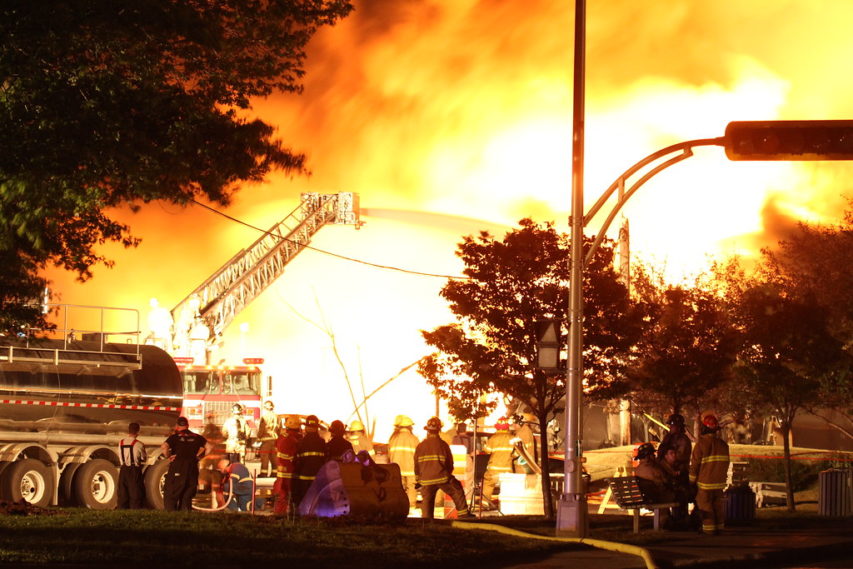
“First responders on site of the Lac-Megantic train derailment” by TSBCanada is licensed under CC BY-NC-ND 2.0
In the beginning, it was standardized, and the best-known codes, like “10-4,” were consistent from town to town or state to state. But it didn’t take long for newer codes to emerge, which often meant different things depending on where you were. Efforts to reorganize the codes every 20 years or so only compounded the problem. On a local level, in any one town, it wasn’t a problem. But when cops or firefighters from different towns had to work together it could lead to disaster.
In 1970, a particularly severe wildfire season in California killed 16 people in a 13-day period and laid bare the cost of bad interagency communication. The rat’s nest of codes, abbreviations, and jargon prevented firefighters from different towns from communicating with the speed and clarity a major disaster demands. To address the problem, the U.S. Forest Service created FIRESCOPE, the first complete system for organizing and managing major incidents. One of the primary principles of this new system was to “develop standard terminology.”
Despite this effort, which later went national and then international (the province of Ontario has its own version, the “Incident Management System”) coded language continued to proliferate. Nearly 30 years after FIRESCOPE was launched, on September 11th, incompatible technology, lack of protocols, and a refusal to harmonize terminology likely contributed to the deaths of 121 firefighters who were caught in the collapse of the North Tower because they either didn’t hear or couldn’t understand the warnings that the building was about to fail.
Which brings us back to 2006, and FEMA’s notice to first responders. After decades of asking agencies to stop using coded language, the federal government made funding contingent on compliance. “The use of plain language in emergency response is a matter of public safety,” the memo’s introduction read. “There simply is little or no room for misunderstanding in an emergency situation.” From that point forward, all interdepartmental communication would have to be un-coded. A fire would be called “fire.” A shooting would be “a shooting.” And if you needed help, you’d say “HELP!”
Police, fire departments and paramedics slowly but surely got on board and started using some form of the incident management system which included plain language. As use of the system spread, other sectors, like large music festivals and other live events, began adopting the concepts to better synchronize public safety programs with the first responders who support them. Today it’s not unusual for producers, technicians and event security staff to attend training at the police college right next to fire captains and police officers.
Then COVID-19 happened, and we realized that no one had told Public Health.
September 22, 2020
QotD: City dwellers and the state
If one wants to understand why city dwellers have a peculiarly statist politics, spend time in a big city subway system. For the people in the city, government services are essential for living. They depend on the subway, the trash collection and the police department. The city depends upon this organic relationship between the state and the citizens. That does not exist in the suburbs or the country. There’s a comfort that comes from the daily interaction with the state. Anyone who questions that relationship is suspect.
The Z Man, “Never Newark Nights”, The Z Blog, 2018-06-06.
September 13, 2020
Irish War of Independence – WW1 Veterans In A New Battle I THE GREAT WAR 1920
The Great War
Published 12 Sep 2020Sign up for Curiosity Stream and get Nebula bundled in: https://curiositystream.com/thegreatwar
The conflict between the Irish independence movement and the UK government had been heating up since 1919. The summer of 1920 brought a new level of escalation with the arrival of the the Auxiliary Division of the Royal Irish Constabulary. Former veterans of the First World War were brought in to quell the rebellion and get hold of the strongholds controlled by the IRA.
» SUPPORT THE CHANNEL
Patreon: https://www.patreon.com/thegreatwar» OUR PODCAST
https://realtimehistory.net/podcast – interviews with World War 1 historians and background info for the show.» BUY OUR SOURCES IN OUR AMAZON STORES
https://realtimehistory.net/amazon *
*Buying via this link supports The Great War (Affiliate-Link)» SOURCES
Hart, Peter: The IRA and Its Enemies (Oxford: Oxford University Press, 1998)Harvey, A.D: “Who Were the Auxiliaries?” The Historical Journal, Vol. 35, No. 3 (Sep. 1992)
Hopkinson, Michael: The Irish War of Independence (Montreal & Kingston: McGill-Queen’s University Press, 2002)
Leeson, David: The Black and Tans: British Police and Auxiliaries in the Irish War of Independence, 1920-1921 (Oxford: Oxford University Press, 2011)
McMahon, Sean: The War of Independence (Cork: Mercier Press, 2019)
O’Brien, Paul: Havoc: The Auxiliaries in Ireland’s War of Independence (Cork: Collins Press, 2017)
Riddell, George: Lord Riddell’s Intimate Diary of the Peace Conference and After: 1918-1923 (London: Victor Gollancz Ltd, 1933)
Roxbourgh, Ian: “The Military: The Mutual Determination of Strategy in Ireland, 1912-1921” in Duyvendak, Jan Willem & Jasper, James M. (eds) Breaking Down the State: Protesters Engaged (Amsterdam: Amsterdam University Press, 2015)
Townshend, Charles: The Republic: The Fight for Irish Independence 1918-1923 (London: Penguin Books, 2014)
“Tubbercurry”, Manchester Guardian, 4 October 1920.
Hugh Martin: “‘Black and Tan’ Force a Failure”, Daily News, 4 October 1920.
» MORE THE GREAT WAR
Website: https://realtimehistory.net
Instagram: https://instagram.com/the_great_war
Twitter: https://twitter.com/WW1_Series
Reddit: https://reddit.com/r/TheGreatWarChannel»CREDITS
Presented by: Jesse Alexander
Written by: Jesse Alexander
Director: Toni Steller & Florian Wittig
Director of Photography: Toni Steller
Sound: Toni Steller
Editing: Toni Steller
Motion Design: Philipp Appelt
Mixing, Mastering & Sound Design: http://above-zero.com
Maps: Daniel Kogosov (https://www.patreon.com/Zalezsky)
Research by: Jesse Alexander
Fact checking: Florian WittigChannel Design: Alexander Clark
Original Logo: David van StepholdContains licensed material by getty images
All rights reserved – Real Time History GmbH 2020
July 29, 2020
Some fascinating and disturbing information on the Nova Scotia murders
Once again, the Halifax Examiner provides information on the mass murder case in Nova Scotia that seems to be mystifyingly of little to no interest to the mainstream media outlets:
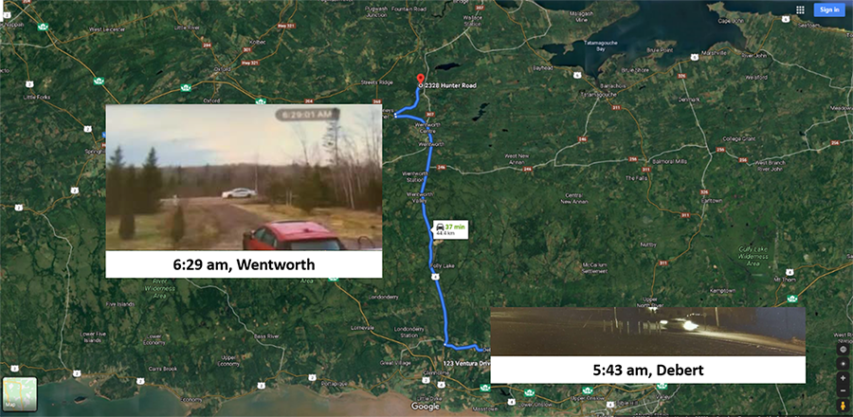
An annotated RCMP map shows the killer’s route from 123 Ventura Drive in Debert to 2328 Hunter Road in Wentworth. Insets of still images taken from different videos show the killer’s replica police car at 5:43am in Debert and passing a driveway on Hunter Road in Wentworth at 6:29am.
The most stunning revelation comes from one person who spoke with Halifax police. That person told police that the murderer, who the Examiner refers to as GW, “builds fires and burns bodies, is a sexual predator, and supplies drugs in Portapique and Economy, Nova Scotia.”
Moreover, the person said that GW “had smuggled guns and drugs from Maine for years and had a stockpile of guns” and GW “had a bag of 10,000 oxy-contin and 15,000 dilaudid from a reservation in New Brunswick.”
Another person who spoke with the RCMP gave information about GW’s properties, relating that it was known that there were secret hiding places at the properties. The person said GW had shown another person (whose name remains redacted) a “hidden compartment in the garage” [presumably in Portapique], which was under a workbench, and GW kept a “high powered rifle” in the space.
The person who spoke with the RCMP said that there was a “false wall” at GW’s Dartmouth residence. That information was echoed by another person who spoke with Halifax police on April 19, who said that “there is a secret room in the clinic in Dartmouth.”
Other information that is newly un-redacted confirms information that was widely known before.
July 20, 2020
The “epic failure” of the RCMP during the Nova Scotia killing spree
In the Halifax Examiner, Paul Palango reconstructs the (known) series of events during the April pursuit of the killer at large in Nova Scotia:
The RCMP has claimed it did its best in trying to deal with the Nova Scotia mass killer on the weekend of April 18 and 19, but a reconstruction of events by the Halifax Examiner strongly suggests that the police force made no attempt to save lives by confronting the gunman or stopping his spree at any point.
“Public safety and preservation of life are the primary duties of any peace officer,” said a former high ranking RCMP executive officer who asked for anonymity out of fear of retaliation by current and former law enforcement officials who are vigilant about any criticism of policing by those in the field. “As far as I can tell, the RCMP did nothing in Nova Scotia to save a life. They weren’t ready. It is embarrassing to me. The entire thing was an epic failure.”
Based upon interviews with other current and former police officers, witnesses, and law enforcement, and on emergency services transcripts, it seems clear that there was a collapse of the policing function on that weekend.
At no point in the two-day rampage did the RCMP get in front of the killer, who the Examiner identifies as GW. It also seems apparent that some Mounties, many of whom were called in from distant locales, were stunningly unaware of the geography and landmarks in the general area as the RCMP tried to keep up with GW.
Sources within the RCMP say a major problem was that communications between various RCMP units was never co-ordinated. “Everyone was on their own channels,” the source said. “Nothing was synchronized. They could have gone to a single channel and brought in the municipal cops as well, but for some reason they didn’t. It was like no one was in charge.”
This incident is revealing:
Several RCMP and law enforcement sources say that a corporal from a nearby detachment who was the initial supervisor on the scene froze in place to the distress of other Mounties. The corporal later ran into nearby woods and turned off their flashlight and hid. That officer continues to be off work on stress leave.
Some veteran Mounties say that there were likely a number of factors which caused the first Mounties on the scene to hesitate.
“It could have been inexperience. Maybe there was no backup. And then there’s always that Canada Labour Code thing,” said one long time Mountie.
The “Canada Labour Code thing” is an interesting insight, although it doesn’t excuse the RCMP’s disorganization and lack of effective leadership over the two days.

An annotated RCMP map shows the killer’s route from 123 Ventura Drive in Debert to 2328 Hunter Road in Wentworth. Insets of still images taken from different videos show the killer’s replica police car at 5:43am in Debert and passing a driveway on Hunter Road in Wentworth at 6:29am.
As they say, “read the whole thing“, as the events unfold with what seems like an endless series of missed opportunities on the part of the RCMP to stop the killings.
H/T to Colby Cosh for the link.
July 12, 2020
Reforming the police
A guest editorial at Catallaxy Files from former Australian senator David Leyonhjelm discusses the original civilian police force, the London Metropolitan Police, and the rules that governed their actions. Contrasting the origins of modern policing, he then discusses the ways police organizations have changed:
One issue is the steady militarisation of the police. This ranges from references to the public as civilians and assertions that the police place their lives on the line every day, to black uniforms, military assault rifles and equipment such as armoured personnel carriers. This is a bigger concern in America, where a lot of military surplus equipment is sold to police and the emphasis on armed conflict is more pronounced, but the trend is the same here.
When they see themselves as soldiers in a war, it is not surprising that some police have no regard for public welfare. The negligence leading to the death of Miss Dhu in police custody in [Western Australia], and of course the notorious deaths in America, are obvious examples of where that leads.
Peel’s principles also stipulate that police should only use physical force when persuasion, advice and warning are insufficient, to use only the minimum force necessary, and that the cooperation of the public diminishes proportionately with the necessity of the use of physical force and compulsion.
Yet how often do we see police resort to violence when making an arrest? People are tackled, forced to the ground with knees on their back and neck amid blows, kicks and the vindictive use of Tasers, simply to apply handcuffs. Being “non-compliant” or raising verbal objections is enough to prompt this, and some have died as a result.
Moreover, when the victims of such treatment are not convicted or imprisoned, such rough handling amounts to a form of punishment. That is also in conflict with Peel’s Principles, which require the police to avoid usurping the powers of the judiciary by authoritatively judging guilt and punishing the guilty.
Enforcement of the Covid rules, including the authoritarian decrees and fines imposed by state premiers, provide further examples: petty closing of cafes, prosecutions for reading in a park, chasing individuals along a closed beach, stopping fishing from a pier the day after 10,000 have gathered in a demonstration, and even a Police Commissioner who denounces the cruise industry as criminal, are among them. The Australian public are never likely to accept the police as one of them while those sorts of things occur.
Change is necessary. Corrupt and thuggish police must be rooted out and the enforcement of laws that the public does not support, including political and victimless crimes, should never have priority. Moreover, arresting people seldom solves problems that originate in drug use, alcoholism, mental illness and poverty.
The fundamental responsibility of governments is to protect life, liberty and property. If the police were to focus on these while upholding Peel’s Principles, Australians might even come to their aid.
July 5, 2020
July 1, 2020
Toronto Police won’t be facing a 10% budget cut after city council votes down proposal
Chris Selley on the vote by Toronto city councillors to retain the existing budget for the city’s police force at $1.22 billion:
On Monday, Toronto City Council debated and passed a variety of proposed police reforms, the newsiest of which had been asking the department to table a 10-per-cent budget cut for 2021. That idea was voted down 16-8. Further proposed changes included asking the Toronto Police Service for a line-item budget, and subjecting police to the municipal auditor-general’s oversight — utterly revolutionary concepts, you will agree. (Both passed.)
The budget cut might at least have been a useful exercise: It would be interesting to know what the police would and wouldn’t do with $1.1 billion instead of $1.22 billion. If I had been a consensus-seeking councillor on the virtual floor, I might have moved a motion asking the police to table line-item budgets for both — and maybe push for 20 or 30 per cent, too. But the question of the budget sucked up too much oxygen.
That’s certainly understandable. The “defund the police” movement in all its permutations is having a moment. There are North American police departments and police unions that might as well be begging to be disbanded, as much with their banal and petulant misbehaviour as with their needless use of lethal force. A few might even get their wish.
Canadian departments haven’t been begging quite as hard, however, and too many Canadians take false solace in that. When it comes to police-involved fatalities, we fare quite poorly against Western nations other than the one next door. Our accountability mechanisms are, generally speaking, a sick joke; indeed, it seems considerably easier to fire flamboyantly terrible cops in the United States than it does here.
James Forcillo, the Toronto officer who was caught on tape fatally unloading nine shots at 18-year-old Sammy Yatim for no good reason, was on the payroll for two-and-a-half years until his criminal conviction. He was at least suspended. Simon Seguin, the Alberta RCMP officer caught on camera in March rugby-tackling, punching and choking Athabasca Chipewyan First Nation Chief Allan Adam in a dispute over an expired vehicle registration, was at the time awaiting trial for assault!
June 23, 2020
The “Battle of Dijon”
I post a lot of accounts of ancient and modern wars and battles, but the “Battle of Dijon” actually took place earlier this month and has been widely mischaracterized in the media, as John Lichfield recounts:

Dijon viewed from Saint-Bénigne Cathedral with the Palace of the States of Burgundy, the Notre-Dame and Saint-Michel churches, the Saint-Nicolas tower, the former Saint-Bénigne abbey palace (ENSA), The Lafayette galleries, the old department stores at Le Pauvre Diable and la Ménagère.
Photo by Twibo2 via Wikimedia Commons (caption translated by Google Translate).
Dijon, the capital of Burgundy, rarely attracts the world’s attention. There is Dijon mustard of course. There is Dijon blackcurrant liqueur (Cassis de Dijon). There are many beautiful, old Burgundian streets and buildings. But of all the medium to large cities in France, Dijon (population: 159,000) is surely the least talked about.
Then, abruptly, last weekend Dijon had the great misfortune to become newsworthy. War broke out, we were told, between “Chechen gangs” and “Arab gangs”. The dispute was, some French media reported, about the right to traffic drugs. The Daily Mail announced that the French army had been sent in to restore order. Marine Le Pen compared Dijon to Beirut. Similar “wars between migrant communities” now threatened, she said, all over France.
All these reports were, I believe, wrong or deeply misleading. What did happen in Dijon over four days the other weekend was surreal and disturbing. But the incidents defy simple explanation or political point-scoring. They say, perhaps, more about Chechnya, and the values — good and bad — of exiled Chechens, than they do about the wider racial issues of France. The severity of the violence probably owed something to the frustrations of France’s recent nine weeks of Covid lockdown. The political and media reaction was skewed by the fact that the events occurred while France was in the midst of a debate about race and policing – in the wake of the George Floyd killing in the United States.
On Sunday evening, on the third night of violence in Dijon, President Emmanuel Macron happened to be addressing the nation on TV. He said, among many other things, that he would resist all pressure to splinter France into ethnic communities.
So what had happened over four days in Dijon? There are several conflicting accounts. Here, briefly, are the facts that I have been able to establish.
On 9th June a 15-year-old (some say 16-year-old) boy of Chechen origin was badly beaten up outside a chicha (hookah) bar in central Dijon. His attackers were local men in their 30s of African and North African origin. According to the Chechen version of events, the men were drug-dealers. The injured boy apparently had no connection with drugs. The dealers attacked him because local Chechens were known to be hostile to drug-trafficking. They put a gun in the boy’s mouth and said: “We hate Chechens. We’re going to let you live so you can tell the other Chechens what’s going to happen to them.”
Three days later a convoy of cars arrived in Dijon packed with Chechen men from several other parts of France, as well as Belgium and Germany. Local media and police say that there were 100 of them; the Chechens say that there were only 15. They smashed up the chicha bar, assaulted its owner and then rampaged through the multi-racial Les Grésilles area of council estates just north-east of central Dijon.



